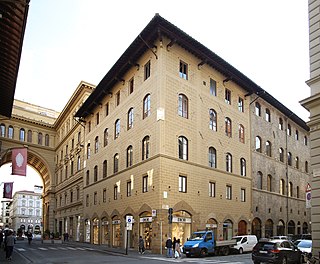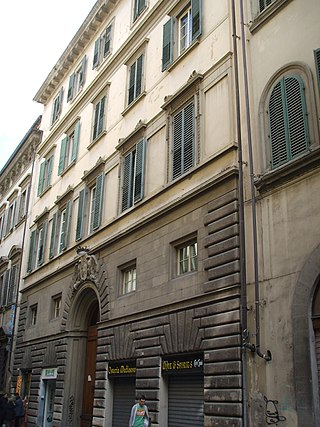
Pietro da Cortona was an Italian Baroque painter and architect. Along with his contemporaries and rivals Gian Lorenzo Bernini and Francesco Borromini, he was one of the key figures in the emergence of Roman Baroque architecture. He was also an important designer of interior decorations.

Giovanni da San Giovanni, also known as Giovanni Mannozzi, was an Italian painter of the early Baroque period, active in Florence.

Giovanni Dupré was an Italian sculptor, of distant French stock long settled in Tuscany, who developed a reputation second only to that of his contemporary Lorenzo Bartolini.

San Gaetano, also known as Santi Michele e Gaetano, is a Baroque church in Florence, Italy, located on the Piazza Antinori, entrusted to the Institute of Christ the King Sovereign Priest.

The Madonna di Galliera is a church with a Renaissance facade and Baroque interiors, located on Via Manzoni, in central Bologna, Italy. It stands in front of the Palazzo Ghisilardi Fava. The present name over the portal is the Chiesa di Filippini Madonna di Galliera e Filippo Neri.

San Filippo Neri is a late-Baroque style, Roman Catholic church located in Turin, region of Piedmont, Italy. The church is located on Via Maria Vittoria 5; the left flank of the nave faces the Turin Academy of Sciences. The church is still used for services. 69 metres (226 ft) long and 37 metres (121 ft) wide, it is the largest church in the city of Turin.

The Casino Mediceo di San Marco is a late-Renaissance or Mannerist style palace located on Via Cavour number 57 and via San Gallo in Florence, region of Tuscany, Italy.

San Carlo dei Lombardi is a Gothic-style, Roman Catholic church located on Via dei Calzaiuoli in central Florence, region of Tuscany, Italy. It has undergone many refurbishments over the year, and was originally dedicated to Sant'Anna e Michele, but since the early 17th century became the church of the local Lombard community and was dedicated to St Charles Borromeo.

The Monument to Giovanni delle Bande Nere is an Italian Renaissance sculpture in marble, by Baccio Bandinelli and his workshop, now in Piazza San Lorenzo in Florence, Tuscany, Italy. The work took from 1540 to after 1560 to carve, and the base and statue, though always meant to be together, were only so placed in 1850.

San Benedetto is a small, Roman Catholic former parish church, then oratory, located in a piazza of the same name just off the piazza of the Duomo of Florence, region of Tuscany, Italy.

The Episcopal Palace is a building located in Piazza Mino of Fiesole, Italy. Built in the eleventh century, it serves as the residence of the Bishop of Fiesole.

Palazzo Bezzoli, or Del Bembo or Martelli, is a civic building in the historical centre of Florence, located between via dei Cerretani 11r-13r-15r-17r-19r and piazza dell'Olio 3. The palazzo appears in the list drawn up in 1901 by the General Directorate of Antiquities and Fine Arts, as a monumental building to be considered national artistic heritage (Italy).

Casa Carlini is a historical building in Florence, located in via de' Pandolfini 33 corner via del Proconsolo 12r-14r. It was the seat from 1497 of the stamperia Giunti.

Palazzo Anselmi Ristori is a building in the historical centre of Florence, located between via de' Sassetti 6 and via degli Strozzi 9r-11r-13r-15r-17r-19r.

Palazzo Bastogi is located at Via dell'Oriuolo 33 in Florence. It houses the Historical Archive of the City of Florence. The palazzo appears in the list drawn up in 1901 by the General Directorate of Antiquities and Fine Arts as a monumental building to be considered.

Palazzo Borghese-Aldobrandini is a building in Florence, located at via Ghibellina 123.

Palazzo Caccini is located in Florence at Borgo Pinti 31–33, on the corner of Via Nuova dei Caccini.

The Palazzo al Canto di Sant'Anna is a building in Florence, composed of two bodies, with one façade on Via de' Pepi 67 and one on Via Fiesolana 32.

Palazzo degli Sporti, or Busini Ugolini, is a civic building in the historical centre of Florence, located between Via dell'Oriuolo 10 and Via Sant'Egidio in Florence, in front of an unnamed small square near the San Pierino arch, where it also leads to Borgo Pinti.

San Filippo Neri, also called the Chiesa dell’Immacolata Concezione is a Baroque-style, Roman Catholic church located located on Via Vittorio Emenuele II # 61 in the town of Chieri, in the Metropolitan City of Turin, region of Piedmont, Italy. The adjacent seminary is now a museum called Centro Visite Don Bosco, recalling the saint's seminary training here during the early 19th century. The church is part of the parish of the Collegiate Church of Santa Maria della Scala, Chieri.






















